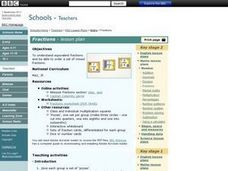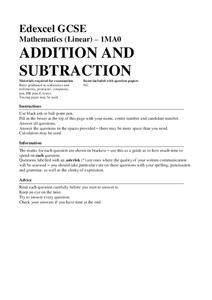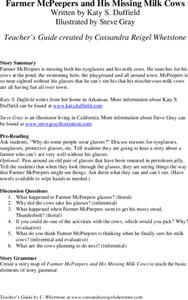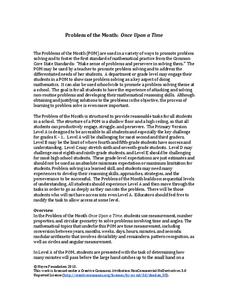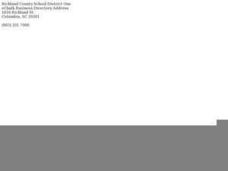K-5 Math Teaching Resources
Base Ten Cards (tens and ones)
Strengthen your class's understanding of place value with this series of base-ten flash cards. Including illustrations representing a variety of numbers from 13 to 94, this resource can be used in many different ways to build the numbers...
Curated OER
Shape Dice
Students roll their way to a better understanding of basic shapes with this printable dice template. Including colorful pictures of two-dimensional shapes on each of its six sides, this resource provides a fun learning experience for...
Curated OER
Fractions Lesson Plan
Students explore equivalent fractions. In this fractions lesson plan, students use strips of paper to recognize equivalent fractions. Students may complete an online activity on an interactive whiteboard as an assessment.
Curated OER
Basic Subtraction Test
Two subtraction test templates feature twenty-one basic equations involving the numbers 1-9. These assessments work best timed; give Test A, then Test B at a later time. Learners can compare the results and observe their progress. Also...
Curated OER
Worksheet 2 - Odd & Even Numbers
Here's a good worksheet to use as a way to assess how well the class understood the lesson on odd and even number. They will mark odd and even numbers, add odd number, add even numbers, mark the odds and evens, then answer 3 related fill...
Curated OER
Christmas Addition
Get in the Christmas spirit with this set of addition worksheets, which each feature an image for young scholars to color in before they solve twelve equations. Learners will get an extra challenge as they deal with all three-digit...
Curated OER
Addition Drill
A basic problem-solving worksheet has scholars completing 10 addition problems. The problems each involve two addends, and have single, double, and triple-digit numbers. Once they have found the sum, they locate the number from the list...
Curated OER
Count Forward from a Given Number
Using images of ice cream cones and carrots, this counting exercise has learners find sets of images with one more than the given set. For the first question, they count a set of six cones, then examine four other sets to indicate the...
Illustrative Mathematics
Overlapping Rectangle
Challenge young mathematicians' ability to compose and decompose shapes with this fun geometry puzzle. The goal is simple, locate all of the rectangles shown in a picture of three overlapping rectangles. Perform this activity as a whole...
Mathed Up!
Addition and Subtraction
After watching a brief video on addition and subtraction, young mathematicians are put to the test. Including 12 problems, individuals solve word problems to find the least number, total amount, and difference of numbers.
Illustrative Mathematics
Counting Squares
Challenge young mathematicians' understanding of squares with this geometry puzzle. The task is simple, identify as many squares as possible in a 3x3 array. Allow learners to work independently or in pairs as they search for squares,...
K20 LEARN
Building To 100: Building And Decomposing Numbers
Following a catchy video about decomposing numbers, young mathematicians build and write numbers using dice. Class members work to create an anchor chart that displays six ways to make numbers. Beans get scooped and estimated, then...
Cassandra Reigel Whetstone
Farmer McPeepers and His Missing Milk Cows
Pair your reading of Farmer McPeepers and His Missing Milk Cows with the questions and activities provided here. Learners answer questions about the text, create story maps, put together brochures, relate math to the story, practice some...
K12 Reader
Conjunctions: And
Math isn't the only subject where pupils get to add! Focus on conjunctions with a grammar lesson in which class members connect nouns with the word and.
K20 LEARN
Building Numbers: Addition And Subtraction Up To 10
Animals on Board! Stuart J. Murphy introduces scholars to composed numbers in preparation for writing and drawing true or false number sentences. A game of Bear in the Cave challenges pupils to locate a missing addend. Sorting number...
American Farm Bureau Foundation for Agriculture
Shapes on the Farm
Whether you live in the city, the suburbs, or out on the farm, shapes are everywhere in the world around us. Presented with an illustration of a farm, youngsters are tasked with coloring in all of the triangles, rectangles, squares, and...
Math in English
3-D Shapes
Young mathematicians look at five 3-D shapes and name them based on the accompanying image. For each shape, learners state the number of faces, vertices, and edges.
Noyce Foundation
Once Upon a Time
Examine the relationship between time and geometry. A series of five lessons provides a grade-appropriate problem from elementary through high school. Each problem asks learners to compare the movement of the hands on a clock to an angle...
Noyce Foundation
Movin 'n Groovin
Examine the consequences of varying speed. An engaging set of five problem sets challenges young mathematicians by targeting a different grade level from K-12. In the initial lesson, scholars make conclusions about the time it takes two...
Illustrative Mathematics
Find the Missing Number
First graders are asked to find the missing numbers in subtraction and addition equations. Each missing number is represented with a box and appears as an addend, subtrahend, sum, or difference.
Illustrative Mathematics
Valid Equalities?
True or false: 20 = 10 + 10. The statement is true because two 10s make a 20. These are the types of equations learners must label or false. They must also explain in mathematical terms how they know.
Illustrative Mathematics
Maria’s Marbles
Ali has more marbles than Maria in some of these word problems, while in others Maria has more marbles than Ali. First graders are tasked to read each word problem and solve how many marbles each girl has.
Illustrative Mathematics
Daisies in Vases
Have your first graders master word problems with an activity that prompts them to find as many combinations for daisies in vases, with the most in the large vase and the least in the small vase. Pupils must also explain their reasoning...
Curated OER
Where are you Spider?
First graders investigate the proximity of objects in space. In this proximity lesson, 1st graders place a felt spider in different locations on a teacher made book, and they describe its proximity to certain items in that book. Students...
Other popular searches
- Math Assessment on Coins
- Elementary Math Assessments
- Math Assessment Test
- Math Assessment Fractions
- Cumulative Math Assessment
- Fitness Assessment Math
- Baseline Math Assessment
- Third Grade Math Assessment
- First Grade Math Assessment
- Grade 4 Math Assessment
- Math Assessment Questions
- Basic Math Assessment




